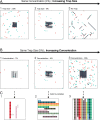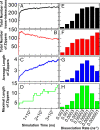On the formation of ordered protein assemblies in cell-cell interfaces
- PMID: 35969779
- PMCID: PMC9407605
- DOI: 10.1073/pnas.2206175119
On the formation of ordered protein assemblies in cell-cell interfaces
Abstract
Crystal structures of many cell-cell adhesion receptors reveal the formation of linear "molecular zippers" comprising an ordered one-dimensional array of proteins that form both intercellular (trans) and intracellular (cis) interactions. The clustered protocadherins (cPcdhs) provide an exemplar of this phenomenon and use it as a basis of barcoding of vertebrate neurons. Here, we report both Metropolis and kinetic Monte Carlo simulations of cPcdh zipper formation using simplified models of cPcdhs that nevertheless capture essential features of their three-dimensional structure. The simulations reveal that the formation of long zippers is an implicit feature of cPcdh structure and is driven by their cis and trans interactions that have been quantitatively characterized in previous work. Moreover, in agreement with cryo-electron tomography studies, the zippers are found to organize into two-dimensional arrays even in the absence of attractive interactions between individual zippers. Our results suggest that the formation of ordered two-dimensional arrays of linear zippers of adhesion proteins is a common feature of cell-cell interfaces. From the perspective of simulations, they demonstrate the importance of a realistic depiction of adhesion protein structure and interactions if important biological phenomena are to be properly captured.
Keywords: adhesion proteins; cell–cell interfaces; clustered protocadherins; ordered protein assemblies.
Conflict of interest statement
The authors declare no competing interest.
Figures






Similar articles
-
Structural insights into the in situ assembly of clustered protocadherin γB4.Nat Commun. 2025 Feb 16;16(1):1682. doi: 10.1038/s41467-025-56948-x. Nat Commun. 2025. PMID: 39956828 Free PMC article.
-
How clustered protocadherin binding specificity is tuned for neuronal self-/nonself-recognition.Elife. 2022 Mar 7;11:e72416. doi: 10.7554/eLife.72416. Elife. 2022. PMID: 35253643 Free PMC article.
-
Visualization of clustered protocadherin neuronal self-recognition complexes.Nature. 2019 May;569(7755):280-283. doi: 10.1038/s41586-019-1089-3. Epub 2019 Apr 10. Nature. 2019. PMID: 30971825 Free PMC article.
-
Confluence and convergence of Dscam and Pcdh cell-recognition codes.Trends Biochem Sci. 2023 Dec;48(12):1044-1057. doi: 10.1016/j.tibs.2023.09.001. Epub 2023 Oct 13. Trends Biochem Sci. 2023. PMID: 37839971 Review.
-
Immunoglobulin superfamily cell adhesion molecules: zippers and signals.Curr Opin Cell Biol. 2007 Oct;19(5):543-50. doi: 10.1016/j.ceb.2007.09.010. Epub 2007 Oct 23. Curr Opin Cell Biol. 2007. PMID: 17935964 Review.
Cited by
-
Structural insights into the in situ assembly of clustered protocadherin γB4.Nat Commun. 2025 Feb 16;16(1):1682. doi: 10.1038/s41467-025-56948-x. Nat Commun. 2025. PMID: 39956828 Free PMC article.
-
Clustered protocadherin cis-interactions are required for combinatorial cell-cell recognition underlying neuronal self-avoidance.Proc Natl Acad Sci U S A. 2024 Jul 16;121(29):e2319829121. doi: 10.1073/pnas.2319829121. Epub 2024 Jul 8. Proc Natl Acad Sci U S A. 2024. PMID: 38976736 Free PMC article.
-
Antibacterial Activity and Mechanism of Litsea cubeba Essential Oil Against Salmonella typhimurium.Plants (Basel). 2025 Apr 29;14(9):1343. doi: 10.3390/plants14091343. Plants (Basel). 2025. PMID: 40364372 Free PMC article.
-
Surface delivery quantification reveals distinct trafficking efficiencies among clustered protocadherin isoforms.Proc Natl Acad Sci U S A. 2025 Aug 5;122(31):e2514178122. doi: 10.1073/pnas.2514178122. Epub 2025 Jul 30. Proc Natl Acad Sci U S A. 2025. PMID: 40737325
-
Histocompatibility in Botryllus schlosseri and the origins of adaptive immunity.Immunogenetics. 2025 May 10;77(1):22. doi: 10.1007/s00251-025-01379-7. Immunogenetics. 2025. PMID: 40347240 Free PMC article. Review.
References
-
- Grakoui A., et al. , The immunological synapse: A molecular machine controlling T cell activation. Science 285, 221–227 (1999). - PubMed
Publication types
MeSH terms
Substances
Grants and funding
LinkOut - more resources
Full Text Sources

